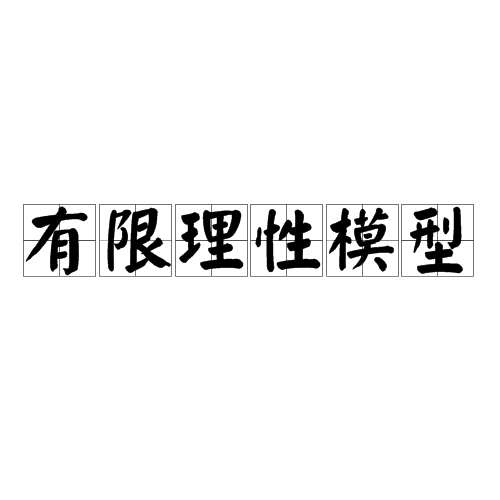主要觀點
(1)手段-目標鏈的內涵有一定矛盾,簡單的手段-目標鏈分析會導致不準確的結論。
西蒙認為,手段-目標鏈的次序系統很少是一個系統的、全面聯繫的鏈,組織活動和基本目的之間的聯繫常常是模糊不清的,這些基本目的也是個不完全系統,這些基本目的內部和達到這些目的所選擇的各種手段內部,也存在著衝突和矛盾。
(2)決策者追求理性,但又不是最大限度地追求理性,他只要求有限理性。
這是因為人的知識有限,決策者既不可能掌握全部信息,也無法認識決策的詳盡規律。比如說,人的計算能力有限,即使藉助計算機,也沒有辦法處理數量巨大的變數方程組;人的想像力和設計能力有限,不可能把所有備擇方案全部列出;人的價值取向並非一成不變,目的時常改變;人的目的往往是多元的,而且互相牴觸,沒有統一的標準。因此,作為決策者的個體,其有限理性限制他作出完全理性的決策,他只能盡力追求在他的能力範圍內的有限理性。
(3)
決策者在決策中追求“滿意”標準,而非最優標準。
在決策過程中,決策者定下一個最基本的要求,然後考察現有的備擇方案。如果有一個備擇方案能較好地滿足定下的最基本的要求,決策者就實現了滿意標準,他就不願意再去研究或尋找更好的備擇方案了。
這是因為一方面,人們往往不願發揮繼續研究的積極性,僅滿足於已有的備擇方案;
另一方面,由於種種條件的約束,決策者本身也缺乏這方面的能力。在現實生活中,往往可以得到較滿意的方案,而非最優的方案。
根據以上幾點,決策者承認自己感覺到的世界只是紛繁複雜的真實世界的極端簡化,他們滿意的標準不是最大值,所以不必去確定所有可能的備擇方案,由於感到真實世界是無法把握的,他們往往滿足於用簡單的方法,憑經驗、習慣和慣例去辦事。因此,導致的決策結果也各有不同。
原文
Herbert Simon (1916-2001) is most famous for what is known to economists as the theory of bounded rationality, a theory about economic decision-making that Simon himself preferred to call “satisficing”, a combination of two words: “satisfy” and “suffice”. Contrary to the tenets of classical economics, Simon maintained that individuals do not seek to maximise their benefit from a particular course of action (since they cannot assimilate and digest all the information that would be needed to do such a thing). Not only can they not get access to all the information required, but even if they could, their minds would be unable to process it properly. The human mind necessarily restricts itself. It is, as Simon put it, bounded by “cognitive limits”.
Hence people, in many different situations, seek something that is “good enough”, something that is satisfactory. Humans, for example, when in shopping mode, aspire to something that they find acceptable, although that may not necessarily be optimal. They look through things in sequence and when they come across an item that meets their aspiration level they go for it. This real-world behaviour is what Simon called satisficing.
He applied the idea to organisations as well as to individuals. Managers do much the same thing as shoppers in a mall. “Whereas economic man maximises, selects the best alternative from among all those available to him,” he wrote, “his cousin, administrative man, satisfices, looks for a course of action that is satisfactory or ‘good enough’.” He went on to say: “Because he treats the world as rather empty and ignores the interrelatedness of all things (so stupefying to thought and action), administrative man can make decisions with relatively simple rules of thumb that do not make impossible demands upon his capacity for thought.”
The principle of satisficing can also be applied to events such as filling in questionnaires. Respondents often choose satisfactory answers rather than searching for an optimum answer. Satisficing of this kind can dramatically distort the traditional statistical methods of market research.
Simon, born and raised in Milwaukee, studied economics at the University of Chicago. “My career,” he said, “was settled at least as much by drift as by choice”, an undergraduate field study developing what became his main field of interest—decision-making within organisations. In 1949 he moved to Pittsburgh to help set up a new graduate school of industrial administration at the Carnegie Institute of Technology. He said that his work had two guiding principles: one was the “hardening of the social sciences”; and the other was to bring about closer co-operation between natural sciences and social sciences.
Simon was a man of wide interests. He played the piano well—his mother was an accomplished pianist—and he was also a keen mountain climber. At one time he even taught an undergraduate course on the French Revolution. He was awarded the Nobel Prize for economics in 1978, to considerable surprise, since by then he had not taught economics for two decades.
有限理性模型的兩種決策方法
從工作任務的不同組合排列中進行選擇,以達到滿意結果的一般性決策方法。
二、方面排除法
這是一種適用於對
決策方案進行同時性選擇的有效方法。

